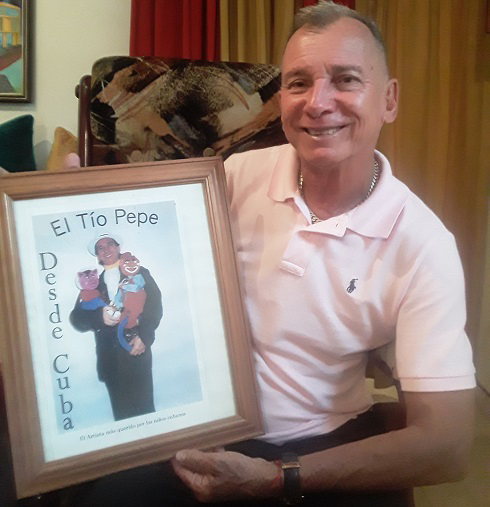
An artist does not die, he immortalizes himself through creation. And although José Bañobre Álvarez, known as El Tío Pepe (Uncle Pepe) is still alive, revisiting in time the stamp of those who, like him, left their mark on our culture is a way of preserving history, that intangible part of the heritage, that beautiful fragment of a city's past.
26 approaches a little at a time, as one who knows that there is a lot of mysticism and virtue in the remembrance of anecdotes that become a treasure if observed from the right prism. Thus, comfortably seated on a piece of furniture in his own home and with the expectation of what this journalist is going to ask me, the interviewee surrenders to the swaying of his memories and the dialogue is not long in coming.
Bañobre has already lived more than 60 springs, but hearing him speak is transfigured. It seems that we are before "a big boy", one of those who weaves and unweaves words, with the passion and simplicity of those who have always worked for love.
In his hands, he holds a folder with a dark façade. What's in it, I wonder curiously. Well, a documentary summary of the work of the Luz Negra group, the one that from the theater brought significant laurels to our land, exponent of a complex technique (as its name indicates) and of a quality still remembered in these premises, although more than three decades have passed.
- Pepe, tell me about your first steps in art.
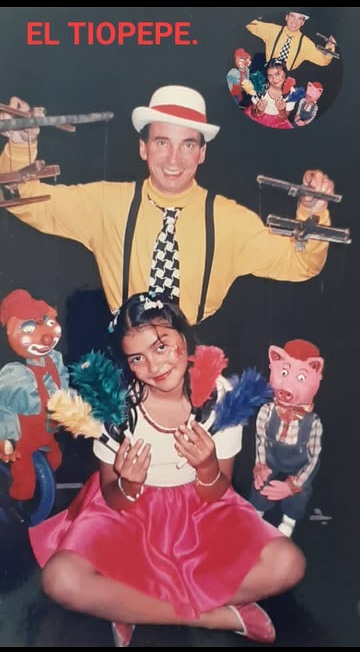 My brother Rolando Tristá (now deceased) was a film projectionist in Las Tunas when I was not even 10 calendars old. I always accompanied him on those adventures. I remember that at the time we used to go every day to some community in the province. There was a cart prepared for that purpose, with a screen and other necessary accessories.
My brother Rolando Tristá (now deceased) was a film projectionist in Las Tunas when I was not even 10 calendars old. I always accompanied him on those adventures. I remember that at the time we used to go every day to some community in the province. There was a cart prepared for that purpose, with a screen and other necessary accessories.
Reaching intricate villages such as La Ceiba and La Esperanza, in the municipality of Majibacoa, and showing a tape there, became a cultural event. People were happy; the bateyes came to life. There came a time when -unconsciously perhaps- I would take a matchbox and simulate a projector, with the help of a pencil and some small pieces of paper that went in and out like a paper theater, and that for my imagination were film reels.
On the other hand, at school -despite being a somewhat shy child for some things- I was the comedian of the classroom, in the good sense of the word. One day my classmates urged me to imitate Chaplin in a matinee. I didn't want to accept because, despite my age, I knew it was a big challenge, but they insisted so much that I did it. I was in fifth or sixth grade. Since then my life changed; I can't explain what I felt on stage, it was magical.
- How did you come to the theater?
Through a call. I worked for many years as an amateur and was a member of the Yagruma group, which won a national festival of manifestation, developed in Santiago de Cuba. I joined Los Zahoríes as such in 1982 and, although at the beginning I was not a professional, I was hired as an actor and performed other functions inherent to technical issues.
Besides, I was part of the management of an independent project related to the art of the stage, because sometimes we noticed that they were married to the work of some creators and we wanted to experiment with new pieces, expand the repertoire and bet on the different; although we did do collective productions.
My friend Ivo Dovale was then one of our outstanding actors and among my close references. When I became a professional, I had the joy of performing many roles with him. In general, it was a golden age for the theater; we did not think so much about money but about making art, those were times of much sacrifice and competition at a national level. We clown even painted ourselves with tempera, without knowing that we could damage our health. But we dreamed, we felt alive and we achieved beautiful things.
I worked in several plays, among them: El gato que apagó el sol, El adivino Cachucho, Los chivitos porfiados, La lechuza ambiciosa, Comino y pimienta, Caballerito a la luna, among many others.
- In such a wide repertoire, which works do you remember most fondly?
I remember a youth play that we premiered at the Luis Urquiza Jorge pre-university, called Sencillamente X, which dealt with the complicated relationship between teachers and students, which goes beyond the limits of education to love relationships. It was a show of great comedy, staged as a parents' meeting, where family members, students, and teachers met to analyze the situation in question.
The characters, for their part, had to give the impression that they were improvising. I played, for example, Celestino Robaina, with nuances similar to those of Panfilo, that old man played today by Luis Silva on national television. There he was the husband of the school principal and the one who pointed the finger when people made mistakes, all within the same plot. It seemed like a play within a play as if the narration was built spontaneously, although logically it was rehearsed.
I also treasure in my heart the show Kigua, which was very transcendent. It was based on the story of El güije, a being from popular mythology who goes into a well to get a bucket of silver and a bucket of gold. Ivo adapted it, it was staged and then we premiered it at the Tunas Theater. Imagine that institution without curtains and full of tree branches; the scenery represented an abandoned hacienda with a well, a paradisiacal place. The play talked about slavery and the insertion of the Spaniards. It was also one of the plays with which I evaluated myself as a professional actor. There I played the character of Tata, a man of strong character, the father of Kigua.
- One of the plays...?
Yes, several projects were presented for evaluation. Since, in addition, some independent ones were accepted, we also took the opportunity to present the Conjunto de Payasos de Las Tunas, the initiative that I told you at the beginning we were cooking up to provide a little outlet for our artistic creative needs. By the 90's we had already materialized it. Within that brotherhood, Ivo was called Bombo and I was called Platillo. And there were other people. We were very much involved in variety shows.
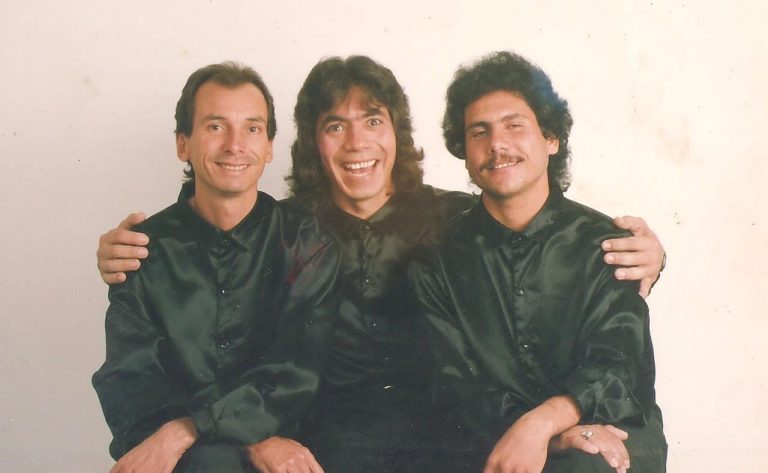 Members of the Luz Negra theater group. From left to right José Bañobre El Tío Pepe, Ivo Dovale and Rafael Argüelles. |
Likewise, we presented Luz Negra as an independent project, at a time when in Cuba there was not a single group working on that technique; we were the first of that nature in the country. We shared Metamorfosis, which later took us to the top of the island's cultural scene, as we won the Villanueva Prize in 1995. It was the first time that a play at the Balcón de Oriente had won that award, in addition to participating in national and international festivals. I had the joy of writing its script. With three standing puppets, manipulated by an equal number of actors, the play had a mixture of techniques.
- Surely, in addition to performances in closed rooms, you also worked in public spaces...
Yes, of course. For example, during carnivals, apart from performing on the main stage, we conducted shows with Mexican, Galician, and other characters. Ivo and I did that task in particular; we liked it very much.
- Tell me a little more about the group Luz Negra, which, as I understand it, marked the scenic history of our territory and even made it beyond our borders.
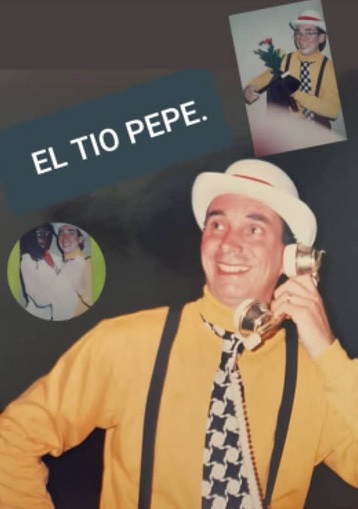 After the evaluation, we decided to promote it with more strength. Besides, we were given the possibility of choosing which project we could defend at the national level and we decided on Luz Negra. We were approved for four places, but all were seen as an independent initiative, although we will always be grateful to the puppet show for cradling our first steps in that direction.
After the evaluation, we decided to promote it with more strength. Besides, we were given the possibility of choosing which project we could defend at the national level and we decided on Luz Negra. We were approved for four places, but all were seen as an independent initiative, although we will always be grateful to the puppet show for cradling our first steps in that direction.
Its materialization was a dream come true in 1994. The group also included Ivo Dovale Alarcón, Rafael Argüelles (Felito), and Jesús Rodríguez Morell (deceased in 1995). We also embraced the art of clowning, puppet theater, and even traditional music. Metamorphosis was one of the works performed with the black light technique and has no words (pure visual poetry), as it tells a story from visuality.
We, as actors, knew about conjuring; I do magic tricks, but in this particular production what we were doing was theatrical magic. If a heron, for example, ate a caterpillar within the plot, we looked for a way to make it as close as possible to the audience: the bird ate the animal and for a moment the latter disappeared.
People loved it, but it was complex. To set up the scenery, it took us four to five hours before each presentation because it involved a lot of magic tricks, in addition, once the show began, three actors walked around the stage in the dark, dressed in black, and the floor, ceiling, and backdrop also had black curtains.
On the other hand, although the project promoted shows in theaters, we carried out a program of activities in schools, neighborhoods, and other places, always adapting to the characteristics of each space. We worked in cabarets as musical comedians and with orchestras (Embajadores del Ritmo, Síncopa...) We also participated in episodes of the police series Día y Noche, which were filmed in Las Tunas.
- I imagine that you also performed alone sometimes...
Yes, of course, I had an independent project called El TIOPEPE, emanating from Luz Negra, with which I did work related to tourism. I was a pioneer here in terms of artistic work aimed at that sector. I started working as a comedian in a cabaret called Copatur, also in El Taíno, the Tunas Hotel, and other facilities.
Then I incorporated Ivo and Felito in the shows; we made presentations of great musical comedy. In 1996 (as a group) we traveled to Mexico, as part of a Puppet Festival. All this is a result of the "Villanueva". Then came several invitations from the El Chopo Museum and prestigious international events. We were triumphing and that made us happy.
Later, we settled in Aztec land, but we came to Cuba from time to time; we never abandoned our roots. Our Cuban roots were our faithful companions. And that is why, in addition to Creole humor and other characteristics, we defended the Cuban pentagram, we played clowns and shows inspired by peasant traditions (for example, Los Chachareros), even with characteristics of the Jornada Cucalambeana and other popular festivities such as the existence of the blue and red sides.
-Tell me about black light as a technique.
The theater itself was born in China, but it became generalized after 1950. It has not been used much in Cuba. A lamp emits ultraviolet electromagnetic radiation at a distance and achieves a magical, dreamlike, tinsel effect on the scene. Imagine fluorescent silhouettes in the middle of the darkness.
- I have heard that music also played a leading role for you.
Yes, in addition to being actors, we split up as a musical trio. In the beginning, we starred in one called Luz Negra (Black Light). We polished our acting, made live music with our repertoire, and defended traditional Cuban genres. The one who had the most knowledge about "the most beautiful form of the beautiful" was Felito, who composed, arranged, and performed on guitar. While Ivo (bongoes) and I (maracas) played other instruments, Ivo also suggested arrangements to Felito.
However, when we arrived in Mexico and worked in restaurants, cabarets, bars, and other places, we decided to form Luz de Cuba. And eventually, we created another group, called Obatalá, which also included Ivo's son, who had great experience in the field. By then we had already reached a certain maturity in that manifestation, based on overcoming, experience, and effort.
- We have talked about many things and, said with that passion, it would seem that everything was easy, but was it so?
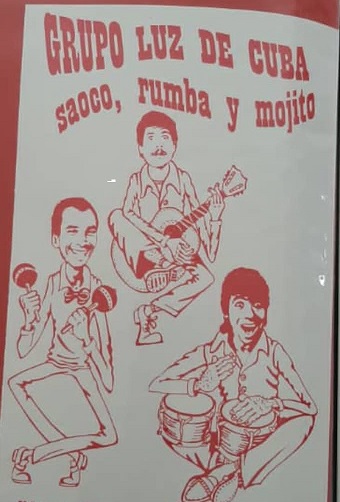 As Luz Negra is an independent project, we covered all the production costs with our own money, such as glue, polystyrene, acrylic, costumes, musical instruments..., as well as trips to Havana, festivals in different provinces and long etcetera. Although we do have to thank authorities such as Alberto Torres, then director of Culture in the province, because he supported us with negotiations and money on occasion.
As Luz Negra is an independent project, we covered all the production costs with our own money, such as glue, polystyrene, acrylic, costumes, musical instruments..., as well as trips to Havana, festivals in different provinces and long etcetera. Although we do have to thank authorities such as Alberto Torres, then director of Culture in the province, because he supported us with negotiations and money on occasion.
We went through bureaucratic hurdles because some people wanted a cast from Havana to leave the country instead of us, despite our results. There were even days when we had to sleep in apartments and portals of the capital because there was not always lodging for so many trips, and days of eating just a croquette to save money... It is worth mentioning that the group Luz Negra obtained all the immigration permits granted by the Cuban government to go abroad, including the Permit for Residence Abroad (PRE).
On the other hand, when we finally managed to get on a plane and return, we could not bring almost anything personally; the weight of the props for the plays we presented filled the authorized pounds per passenger. Once, for example, we were given rolls of black cloth (which we needed) and we couldn't bring them. But what remains is that -despite the vicissitudes- we defended creation and left a mark in people's souls.
Something very nice is that Ivo, Felito, and I are spiritual people and, before starting any show, we would pray to God for about 15 minutes, holding hands. We were very disciplined with our work, and that is the reason for our success.
...
I finish the interview and it's pouring rain outside. Pepe smiles and his eyes shine with satisfaction for traveling through time with the help of journalism. He tells me that he intends to settle permanently in Las Tunas (he is currently Cuban-Mexican-American) and I think how wise it would be to drink from his experience in the art of the stage. For the moment, I am left with that image of a "big boy" who, between simplicity and charisma, opened his heart to share important scenes of our theatrical history.





